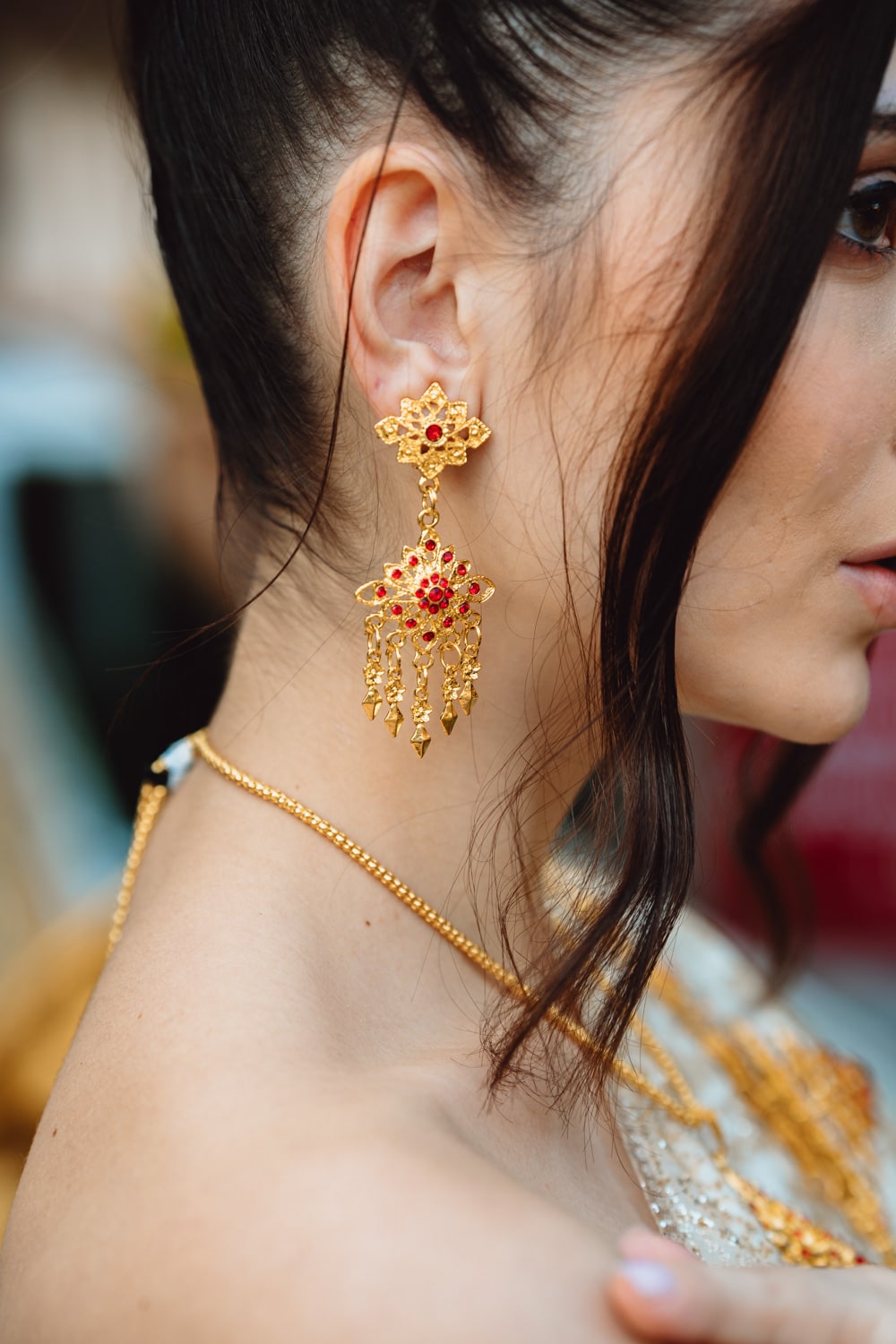The Cultural Significance of Thai Headdresses
Thai headdresses represent more than just beautiful accessories for traditional Thai costumes. These elaborate crown-like structures, often worn as part of a complete chut thai ensemble, tell stories of Thailand’s rich cultural heritage spanning centuries. When visitors come to Bangkok seeking authentic experiences, many are drawn to the exquisite craftsmanship of these headdresses, which feature prominently in traditional ceremonies, classical dance performances, and even modern wedding ceremonies. The intricate details of each headdress speak volumes about Thailand’s artistic traditions, with patterns and materials carefully selected to convey specific meanings. At SiamCrown, located in the heart of Bangkok’s historic district, visitors can experience these magnificent pieces firsthand through their thai costume rental services, allowing tourists and locals alike to connect with this important aspect of Thai cultural identity.
Regional Variations in Thai Headdress Designs
Thailand’s geographical diversity has influenced the development of distinct headdress styles across different regions of the country. Northern Thai headdresses often incorporate elements from Lanna culture, featuring more delicate metalwork and sometimes using silver rather than gold. In contrast, central Thai designs, which are most commonly associated with royal court traditions, tend to be more elaborate with multiple tiers and extensive gold ornamentation. Southern Thai headdresses sometimes show Malay influences in their patterns and construction techniques. These regional differences reflect the unique historical developments and cultural exchanges that have shaped each area’s artistic expression. For those interested in exploring these variations, wearing a complete chut thai outfit with the appropriate regional headdress offers a deeper understanding of Thailand’s cultural complexity. Traditional costume enthusiasts often visit specialized shops like SiamCrown to learn about these regional distinctions and select historically accurate ensembles for special occasions or photography sessions.
Materials and Craftsmanship: The Making of a Thai Headdress
The creation of a traditional Thai headdress represents the pinnacle of Thai craftsmanship, requiring extraordinary skill and patience. Most elaborate headdresses begin with a base structure made from sturdy materials like rattan or metal wire, which is then covered with fabric and adorned with decorative elements. Gold leaf or gold-colored metal is commonly used for royal or ceremonial headdresses, while more affordable versions might use brass or gold-colored synthetic materials. Gemstones—either genuine or imitation—add color and sparkle, with different stones carrying specific symbolic meanings. Red stones often represent power and vitality, while green may symbolize growth and prosperity. The most intricate pieces require hundreds of hours of meticulous handwork by skilled artisans who have inherited techniques passed down through generations. Today, those interested in thai costume rental options can appreciate this craftsmanship without the substantial investment of purchasing these elaborate pieces outright. Visitors to Bangkok can explore the craftsmanship behind these magnificent creations at specialty shops like SiamCrown, where staff can explain the significance of different design elements.
Symbolic Elements in Traditional Thai Headdresses
Every element of a traditional Thai headdress carries symbolic meaning, creating a visual language that communicates status, occasion, and cultural values. The pointed structure often seen in royal headdresses, called a yod, represents Mount Meru—the sacred mountain in Hindu and Buddhist cosmology that stands at the center of the physical, metaphysical, and spiritual universes. The number of tiers or levels in a headdress can indicate the wearer’s social standing, with more elaborate multi-tiered designs reserved for royalty or deities in theatrical performances. Common motifs include naga (mythical serpents), kinnaree (half-human, half-bird creatures), and various floral designs that reference natural abundance and beauty. These symbols connect the wearer to Thailand’s spiritual traditions and mythological heritage. When tourists rent a chut thai with an accompanying headdress, they’re participating in this rich symbolic tradition, which adds depth to the experience beyond mere aesthetic appreciation. Knowledgeable staff at establishments like SiamCrown can help explain these symbolic elements, enhancing visitors’ appreciation of Thai cultural heritage.
Headdresses in Traditional Thai Dance and Performance
The relationship between Thai headdresses and performing arts is particularly significant, with specific designs being integral to different forms of traditional dance and theater. In khon performances—Thailand’s classical masked dance drama—headdresses help identify different characters from the Ramakien (the Thai version of the Indian Ramayana epic). Divine characters and royalty wear tall, elaborate crowns, while monkeys and demons have distinctive headpieces that emphasize their supernatural qualities. In lakhon dance dramas, female performers often wear chada headdresses with cascading jasmine garlands that create beautiful flowing movements as they dance. The weight and structure of these headdresses require dancers to develop specific techniques and posture to move gracefully while supporting these sometimes heavy structures. Visitors to thailand who attend traditional performances often become fascinated by these beautiful costume elements and seek out thai costume rental opportunities to experience wearing these pieces themselves. Cultural enthusiasts can discover more about the connection between headdresses and performance traditions through the educational resources provided by specialty shops like SiamCrown.
Royal Thai Headdresses: Symbols of Monarchical Tradition
The most splendid Thai headdresses are those associated with Thailand’s royal traditions, which reflect the sacred status of monarchy in Thai culture. Throughout history, royal headdresses served as powerful visual statements of legitimacy and divine connection. The great crown of Thailand, worn during coronation ceremonies, represents the culmination of this tradition with its multi-tiered structure and abundant use of precious materials. Royal consorts and children historically wore slightly less elaborate but still magnificent headdresses appropriate to their rank. These designs have influenced the development of bridal headdresses in Thailand, as wedding attire often borrows elements from royal traditions. Today, many Thai people choose to wear traditional royal-style chut thai for important ceremonies and photoshoots, connecting with their cultural heritage. Specialty shops offering thai costume rental services, such as SiamCrown in Bangkok’s historic district, provide access to high-quality replicas of these royal designs, allowing people to experience the majesty of Thailand’s royal traditions regardless of their background.
Modern Adaptations: Thai Headdresses in Contemporary Settings
While deeply rooted in tradition, Thai headdresses continue to evolve in contemporary settings, finding new relevance in modern Thai society. Today’s fashion designers draw inspiration from traditional headdress elements, creating innovative accessories that reference cultural heritage while appealing to contemporary aesthetics. Simplified versions of traditional designs appear in modern wedding attire, where brides may choose more lightweight and comfortable adaptations that maintain the visual impact of historical pieces. International costume enthusiasts and performers have also embraced elements of Thai headdress design, incorporating them into fusion performances and global fashion. Photography studios specializing in traditional costume portraits have become increasingly popular among both tourists and locals, creating demand for high-quality chut thai rental options complete with appropriate headdresses. These contemporary adaptations ensure that the artistic tradition of Thai headdresses remains vibrant and relevant. For those interested in exploring the intersection of tradition and modernity, establishments like SiamCrown offer both strictly traditional pieces and more contemporary adaptations suitable for various occasions.
Experiencing Thai Headdresses: Visitor Opportunities in Bangkok
Visitors to Bangkok have numerous opportunities to experience and learn about traditional Thai headdresses firsthand. Beyond observing them in museums or performances, many travelers enjoy the immersive experience of wearing these magnificent pieces as part of a complete chut thai ensemble. Professional photography sessions in traditional costume have become a popular cultural activity, allowing visitors to create memorable souvenirs while gaining appreciation for Thai craftsmanship. Several specialized shops in Bangkok’s historic districts offer thai costume rental services with knowledgeable staff who can explain the historical and cultural significance of different headdress styles. For the most authentic experience, visitors should seek establishments that maintain high standards of quality and historical accuracy in their costume collections. Located in Bangkok’s Samphanthawong district, SiamCrown provides visitors with expertly curated traditional costume collections and educational information about the historical significance of different headdress styles. Whether for photography, special events, or simply cultural appreciation, experiencing a traditional Thai headdress offers insight into Thailand’s artistic heritage that goes far beyond ordinary tourism activities.



